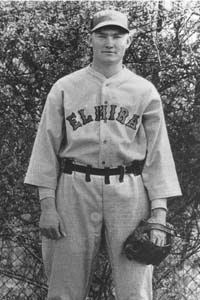

Willie Kamm was born in San Francisco in 1900, the son of German immigrants. He grew up playing the game in the streets, a game that his parents never truly understood, even as Kamm became a major league player. A skinny kid with a good glove, Kamm signed with Sacramento in the PCL in 1918, but was released after a mere four games. He signed on with the San Francisco club the following year, but could not get his average out of the .230's in two seasons.
In 1920, following the removal of his tonsils, Kamm put on weight, and began to hit the ball with more authority. Hitting better, and now the best third baseman defensively in the PCL, he was sold to the Chicago White Sox in May of 1922 for a then-unheard of sum of $100,000 ($1.3 million in 2010). Kamm joined the Sox in April of 1923, and over the next seven seasons was the best fielding third baseman in the league, if not the best overall. He batted a solid .281 over that stretch, including a career best .308 in 1928.
After a sub-par 1930. Kamm was traded to the Indians for the 1929 batting champ, Lew Fonseca. The trade, initially disliked by Kamm, was a boost to his career. He batted .291 in 1931, and followed that with two more seasons in the .280's.
By spring of 1935, Kamm, now 35 years of age, had slowed considerably, and by May was released by the Indians. In his 14 years, he batted a very commendable .281 with over 1600 hits. He was also retired with the best fielding percentage by a third baseman at the time (.967), a number since passed.
Kamm returned to California after his playing days, managing in the PCL for a few seasons. He enjoyed the boost in fame he received from Lawrence Ritter's book "The Glory of Their Times," published in 1966. He died in 1988 at the age of 88.
Kamm was a sure and steady player, a model of consistency. One of the players who are forgotten once their playing days ended, it is only through Ritter's book that his name is even slightly remembered today. Had there been All-Star games during his playing days, he would have been on the AL squad year-after-year. When I think of Willie Kamm and try to contemporize his fame, the first two names I come up with are Doug Decinces and Roy Smalley. Smalley and Decinces had nice long careers at shortstop and third base, respectively. Most teams in the AL would have considered their addition to be a marked upgrade to what they currently had there. But the second their careers ended..... well, you don't hear many people talking about Roy Smalley and Doug Decinces these days, do you?
Just out of interest on Kamm's defense, here are the career fielding percentage and chances per game between Kamm and Brooks Robinson. Robinson is generally regarded as the best defensive third basemen ever. Although it is hard to really gage defensive ability through statistics, Kamm had more chances per game, and his fielding percentage vs the league (.948 league avg) is the same 19-point difference as Robinson (.952). I am not saying Kamm was better; I've never even seen film of Kamm (if it exists). I am just saying it is an interesting comparison. I'll even throw Graig Nettles into the mix.
Robinson .971 (.952) 3.20
Kamm .967 (.948) 3.28
Nettles .961 (.952) 2.98
Being from Detroit, I hear a lot about how current Tiger third baseman Brandon Inge is great defensively. Yes, he makes some great plays, and most of his errors are throwing errors. But his career numbers don't come anywhere near Kamm or Robinson. Neither does 2009 AL Gold Glove winner Evan Longoria (with his '09 stats only shown)
Inge .958 (.957) 2.88
Longoria .970 (.956) 2.74
I'll let you Jamesian guys interpret that all you want. I realize that other things affect fielding stats (height of infield grass, bunts vs. smashes down the line, equipment, and so on.) I just think it shows that Kamm may have been better than advertised.
The Autograph: Kamm was a great guy to get autographs from through the mail. He loved being remembered, even if it was only from people who read "Glory" and not from people who saw him play.
In the picture below, from the 1931 Tour of Japan, Kamm can be seen in the top row, third from the right.
Top Row, L-R: Rabbit Maranville, Beans Reardon (maybe), Ralph Shinners, George Kelly, Al Simmons, Tom Oliver, Willie Kamm, Doc Knolls (the trainer), Lou Gehrig.
Bottom Row, L-R: Larry French, Lefty Grove, Muddy Ruel (nice socks), Fred Lieb (the writer), Sotaro Suzuki, Lefty O'Doul, Bruce Cunningham, Frankie Frisch, Mickey Cochrane. Herb Hunter is the dude standing over Al Simmons.












